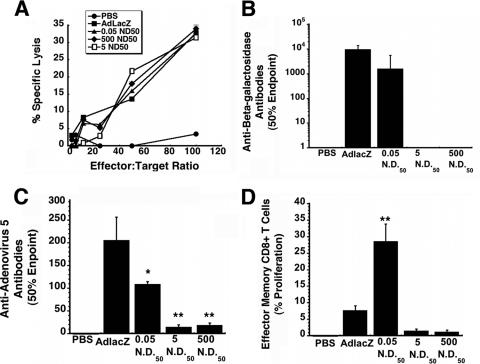Fig 4.
VACs at a concentration of 0.05 ND50 can elicit strong T-cell mediated and humoral immune responses against an encoded transgene. (A) CTL responses elicited by VACs. Splenocytes harvested 10 days after treatment were restimulated in vitro for 5 days and tested for specific lysis on MC57 target cells infected with adenovirus expressing beta-galactosidase in a 6-h 51Cr release assay. Percent specific lysis is expressed as a function of different effector-to-target ratios (6:1, 12.5:1, 25:1, 50:1, and 100:1). (B) Anti-beta-galactosidase neutralizing antibody profile after a single dose of VACs in C57BL/6 mice. Serum was analyzed 28 days after treatment for the presence of antibody to beta-galactosidase. Fifty percent endpoint titers were calculated according to the method of Reed and Muench. (C) Anti-adenovirus neutralizing antibody levels. The presence of neutralizing antibody against the adenoviral vector was determined by assessing the ability of collected sera to block infection of HeLa cells by virus expressing beta-galactosidase. The 50% endpoint titer is plotted according to treatment. (D) Memory response. Splenocytes were isolated 42 days after treatment, stained with CFSE, and stimulated with beta-galactosidase-specific peptide for 5 days. Cells positive for CD8+, CD44hi, and CD62Llo were evaluated for CFSE staining by flow cytometry. Data represent the degree of effector CD8 T cell expansion after stimulation. Data illustrated in each panel reflect the means and standard deviations of results for five animals per group. Statistical significance was determined between individual treatment groups and vehicle controls by one-way analysis of variance with a Bonferroni/Dunn post hoc test. *, P ≤ 0.05; **, P ≤ 0.01.

